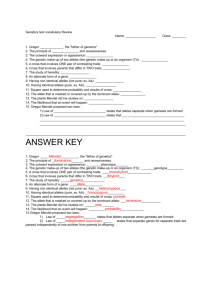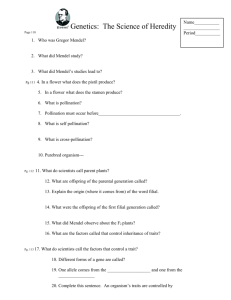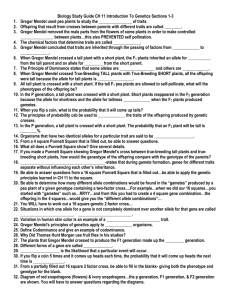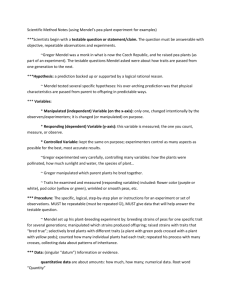Class Presentation Questions CH 11
advertisement
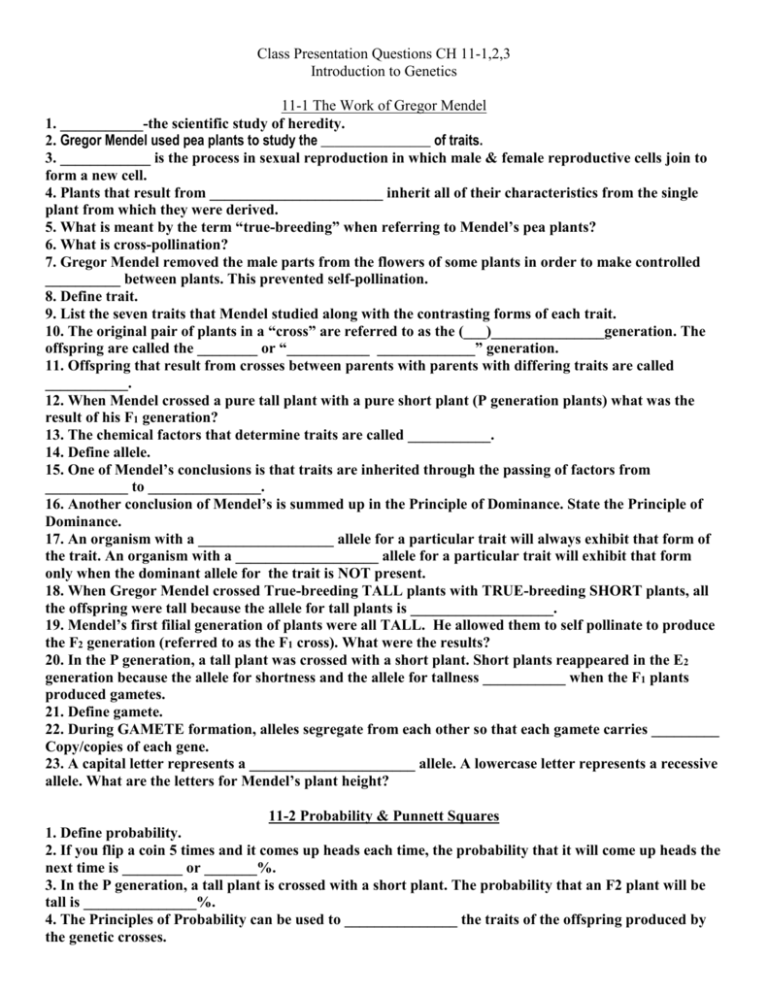
Class Presentation Questions CH 11-1,2,3 Introduction to Genetics 11-1 The Work of Gregor Mendel 1. ___________-the scientific study of heredity. 2. Gregor Mendel used pea plants to study the ________________ of traits. 3. ____________ is the process in sexual reproduction in which male & female reproductive cells join to form a new cell. 4. Plants that result from _______________________ inherit all of their characteristics from the single plant from which they were derived. 5. What is meant by the term “true-breeding” when referring to Mendel’s pea plants? 6. What is cross-pollination? 7. Gregor Mendel removed the male parts from the flowers of some plants in order to make controlled __________ between plants. This prevented self-pollination. 8. Define trait. 9. List the seven traits that Mendel studied along with the contrasting forms of each trait. 10. The original pair of plants in a “cross” are referred to as the (___)_______________generation. The offspring are called the ________ or “___________ _____________” generation. 11. Offspring that result from crosses between parents with parents with differing traits are called ___________. 12. When Mendel crossed a pure tall plant with a pure short plant (P generation plants) what was the result of his F1 generation? 13. The chemical factors that determine traits are called ___________. 14. Define allele. 15. One of Mendel’s conclusions is that traits are inherited through the passing of factors from ___________ to _______________. 16. Another conclusion of Mendel’s is summed up in the Principle of Dominance. State the Principle of Dominance. 17. An organism with a __________________ allele for a particular trait will always exhibit that form of the trait. An organism with a ___________________ allele for a particular trait will exhibit that form only when the dominant allele for the trait is NOT present. 18. When Gregor Mendel crossed True-breeding TALL plants with TRUE-breeding SHORT plants, all the offspring were tall because the allele for tall plants is ___________________. 19. Mendel’s first filial generation of plants were all TALL. He allowed them to self pollinate to produce the F2 generation (referred to as the F1 cross). What were the results? 20. In the P generation, a tall plant was crossed with a short plant. Short plants reappeared in the E2 generation because the allele for shortness and the allele for tallness ___________ when the F1 plants produced gametes. 21. Define gamete. 22. During GAMETE formation, alleles segregate from each other so that each gamete carries _________ Copy/copies of each gene. 23. A capital letter represents a ______________________ allele. A lowercase letter represents a recessive allele. What are the letters for Mendel’s plant height? 11-2 Probability & Punnett Squares 1. Define probability. 2. If you flip a coin 5 times and it comes up heads each time, the probability that it will come up heads the next time is ________ or _______%. 3. In the P generation, a tall plant is crossed with a short plant. The probability that an F2 plant will be tall is _______________%. 4. The Principles of Probability can be used to _______________ the traits of the offspring produced by the genetic crosses. 5. ____________________-diagram showing the gene combinations that might result from a genetic cross. DRAW an EXAMPLE from your text! 6. Organisms that have TWO IDENTICAL alleles for a particular trait are said to be _________________ and are ________________ -________________ for that trait. They are represented with two letters of the SAME CASE. 7. ____________________________ organisms are hybrids. They are represented with an upper case and lower case letter combination. 8.Define phenotype. 9. Define genotype. 10. List 4 things that a punnet square can shows us. 11. Punnet squares can be used to ___________ & ___________ the genetic variations that result from a cross. 12. Gregor Mendel’s principles of genetics apply to ______ organisms. 13. The plants that Gregor Mendel crossed to produce the F1 generation made up the ______ generation. 14. If you made a punnett square between Mendel’s true-breeding tall plants and true-breeding short plants, how would the genotype of the offspring compare with the genotype of the parents? 15. An F1 plant that is homozygous for shortness is crossed with a heterozygous F1 plant. What is the probability that a seed from the cross will produce a tall plant? Use a punnett square to explain your answer AND to compare the probable genetic variations in the F2 plants. 11-3 Exploring Mendelian Genetics 1.__________-__________ __________________=Crosses that involve two traits, such as pod color and pod shape. 2._______________________________ states that during gamete formation, genes for different traits separate without influencing each other’s inheritance. This accounts for the many genetic variations observed in plants, animals and other organisms. 3. Write the four Mendelian Principles of Genetics. 4. Not all genes show simple patterns of dominant & recessive alleles. The majority of genes have more than two alleles. So we say they are controlled by ___________ alleles or ______________ genes. 5. Situations in which one allele is not completely dominate over another allele for that gene are referred to as _______________________ _______________________. (EX: Red flowers RR x White Flowers WW= RW pink flowers…a phenotype somewhere in between the two parental phenotypes) 6. _________________________-situation in which both alleles of a gene contribute to the phenotype of the organism. (EX: Roan cattle & horses…Dominecker chickens that are black and white spotted) 7. Even though some traits can have multiple alleles (more than 2), organisms can only inherit two of the alleles. Why? 8. Rabbit coat color is determined by a single gene that has at least _____ different alleles. Human _________ type has multiple alleles. 9. Many traits are produced by the interaction of several GENES. Traits controlled by two or more GENES are said to be _________________ traits, which means “______________________________”. Variation in human skin color is an example of this. 10. Why did Thomas Hunt Morgan use fruit flies in his studies?(list three reasons!) 11. What is the scientific name for the fruit fly. Be sure to write it correctly…capitalize the first name! and be sure to underline each part separately. 12. Complete a 2 factor cross using the following parents: rryy x RrYy… This is a 16 square…I would recommend using color pencils when you determine phenotypes & would draw the phenotypes in. Be sure to do the two 4 square crosses to get you started!


